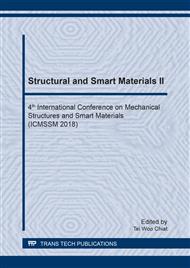[1]
A.P. Mouritz, M.K. Bannister, P.J. Falzon, Review of applications for advanced three-dimensional fibre textile composites, Composites. A. 30 (1999) 1445-1461.
DOI: 10.1016/s1359-835x(99)00034-2
Google Scholar
[2]
J.N. Baucom, M.A. Zikry, Evolution of failure mechanisms in 2d and 3d woven composite systems under quasi-static perforation, J. Comp. Mater. 37 (2003) 1651-1674.
DOI: 10.1177/0021998303035178
Google Scholar
[3]
X.G. Yu, J.Z. Cui, The prediction on mechanical properties of 4-step braided composites via two-scale method, Compos. Sci. Technol. 67 (2007) 471-480.
DOI: 10.1016/j.compscitech.2006.08.028
Google Scholar
[4]
M. Ansar, X. Wang, C. Zhou, Modeling strategies of 3D woven composites: A review, Compos. Struct. 93 (2011) 1947-1963.
Google Scholar
[5]
S. Dai, P.R. Cunningham, Multi-scale damage modelling of 3D woven composites under uni-axial tension, Compos. Struct. 142 (2016) 298-312.
DOI: 10.1016/j.compstruct.2016.01.103
Google Scholar
[6]
B. Chen, T.W. Chou, Compaction of woven-fabric preforms in liquid composite molding processes: single-layer deformation, Compos. Sci. Technol. 59 (1999) 1519-1526.
DOI: 10.1016/s0266-3538(99)00002-0
Google Scholar
[7]
H. Lin, M. Sherburn, J. Crookston, Finite element modelling of fabric compression, Modell. Simul. Mater. Sci. Eng. 16 (2008) 1-16.
DOI: 10.1088/0965-0393/16/3/035010
Google Scholar
[8]
T.M. Mcbride, J. Chen, Unit-cell geometry in plain-weave fabrics during shear deformations, Compos. Sci. Technol. 57 (3) (1997) 345-351.
DOI: 10.1016/s0266-3538(96)00136-4
Google Scholar
[9]
E.J. Barbero, J. Trovillion, J.A. Mayugo, Finite element modeling of plain weave fabrics from photomicrograph measurements, Comput. Struct. 73 (1) (2006) 41-52.
DOI: 10.1016/j.compstruct.2005.01.030
Google Scholar
[10]
J.C. Michel, H. Moulinec, P. Suquet, Effective properties of composite materials with periodic microstructure: a computational approach, Comp. Methods. Appl. Mech. Eng. 172 (1-4) (1999), 109-143.
DOI: 10.1016/s0045-7825(98)00227-8
Google Scholar
[11]
S. Li, Boundary conditions for unit cells from periodic microstructures and their implications, Compos. Sci. Technol. 68 (9) (2008) 1962-1974.
Google Scholar
[12]
Z. Xia, Y. Zhang, F. Ellyin, A unified periodical boundary conditions for representative volume elements of composites and applications, Int. J. Solids. Struct. 40 (2003) 1907-1921.
DOI: 10.1016/s0020-7683(03)00024-6
Google Scholar
[13]
J.L. Gorczyca-Cole, J.A. Sherwood, J. Chen, A friction model for thermostamping commingled glass-polypropylene woven fabrics, Composites Part A: Applied Sci. Manuf. 38 (2) (2007) 393-406.
DOI: 10.1016/j.compositesa.2006.03.006
Google Scholar
[14]
C.C. Chamis, Mechanics of composite materials - Past, present and future, J. Compos. Technol. Res. 11 (1) (1989) 3-14.
Google Scholar


